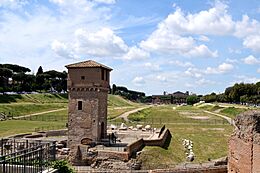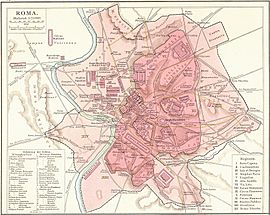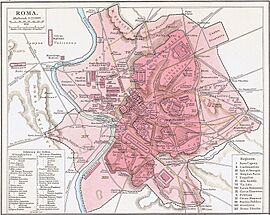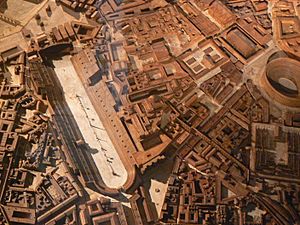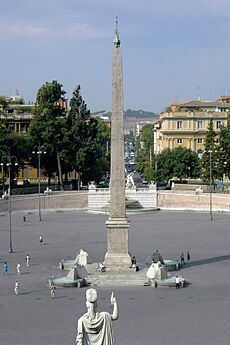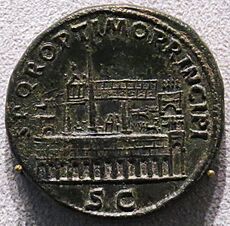Circus Maximus facts for kids
The Circus Maximus (which means "largest circus" in Latin) was an amazing ancient Roman stadium. It was located in Rome, Italy, in the valley between the Aventine and Palatine hills. This was the first and biggest stadium in ancient Rome and its later Empire.
The Circus Maximus was mainly used for exciting chariot races. It also hosted many other public entertainment events. It measured about 621 meters (2,037 feet) long and 118 meters (387 feet) wide. This huge venue could hold over 150,000 spectators! In its most developed form, it became the blueprint for other circuses throughout the Roman Empire. Today, the site is a large public park where people can gather and enjoy the open space.
Contents
Discovering Events and Uses at the Circus Maximus
The Circus Maximus was Rome's largest place for ludi. These were public games connected to Roman religious festivals. Important Romans or the Roman state sponsored ludi for the Roman people and their gods. Most of these games happened every year or at regular times on the Roman calendar. Sometimes, games were held to fulfill a religious promise, like celebrations after a victory.
Ludi could last from half a day to several days. They included religious ceremonies, public feasts, and many types of entertainment. There were horse and chariot races, athletic contests, plays, and recitals. Sometimes, there were also beast-hunts and gladiator fights. The biggest ludi at the Circus started with a grand parade called a (pompa circensis). This parade was similar to a victory procession. It showed the purpose of the games and introduced all the participants.
During the Roman Republic, officials called aediles organized the games. Organizing the most expensive ludi showed how capable and generous an aedile was. This could help them get higher political positions. However, some Circus events were smaller and more personal. For example, in 167 BC, "flute players, scenic artists and dancers" performed on a temporary stage. This stage was likely set up between the two central seating areas. Other events were very large and costly. A venatio (beast-hunt) in 169 BC featured "63 leopards and 40 bears and elephants." Spectators were kept safe by a strong barrier.
As Rome grew, politicians created more ludi to gain public support. By the late Republic, games were held on 57 days a year. Many of these would have used the Circus Maximus. On other days, charioteers and jockeys practiced on the track. The Circus also served as a place to hold animals traded in the nearby Forum Boarium. Under the outer stands, near the entrances, were workshops and shops. When no games were happening, the Circus was a busy, colorful area. Many different people, including performers and vendors, gathered there.
Roman emperors later took on the role of organizing ludi. They met the public's demand for regular games. Over time, the Circus Maximus became Rome's main place for chariot races. By the late 1st century AD, the Colosseum hosted most gladiator shows and smaller beast-hunts. Most track athletes competed at the Stadium of Domitian. However, long-distance foot races still took place at the Circus. Eventually, 135 days of the year were dedicated to ludi.
Even as a chariot-racing circuit, the Circus remained important for large religious parades. It was also the most popular place for big venationes. In the late 3rd century, Emperor Probus put on a spectacular show. Beasts were hunted through a real forest of trees on a specially built stage. As Christianity became the official religion of the Empire, ludi slowly became less popular. The last known beast-hunt at the Circus Maximus was in 523 AD. The last recorded races were held by Totila in 549 AD.
Building the Circus Maximus: A Look at Its Design
Early Days: The Regal Era
The Circus Maximus was built on the flat ground of the Valley of Murcia. This valley lies between Rome's Aventine and Palatine Hills. In Rome's earliest times, this valley was rich farmland. It often flooded from the Tiber river and a stream running through it. The stream was likely bridged early on where the track crossed it. The first races probably happened in this farming landscape. There were only turning posts, banks for spectators, and a few shrines.
According to Livy's History of Rome, the first Etruscan king of Rome, Lucius Tarquinius Priscus, built raised wooden seating. This was for Rome's most important people, like the equites and patricians. It was probably along the Palatine side, with an awning for shade and rain. His grandson, Tarquinius Superbus, added the first seating for ordinary citizens (plebs). This was either next to the existing seats or on the opposite Aventine side. Otherwise, the Circus was still mostly a track through farmland. The wooden stands and seats often rotted and had to be rebuilt. The turning posts (metae), made of three stone pillars, might have been the first permanent structures. An open drainage canal between the posts served as a dividing barrier.
Growth During the Republican Era
The person sponsoring the games (called the editor) usually sat on a special raised stand called a pulvinar. This stand was next to images of the gods. Seats along the track offered the best views of the exciting races. In 494 BC, Manius Valerius Maximus and his family were given special rights. They could have a curule chair at the southeastern turn, a great spot for watching the action. In the 190s BC, stone seating was built along the track, just for senators.
Permanent wooden starting stalls were built in 329 BC. They had gates and were brightly painted. They were also staggered to make sure each chariot started the same distance from the central barrier. Originally, they might have held up to 25 four-horse chariots. But when team-racing began, they were made wider and fewer in number. By the late Republic or early Imperial era, there were twelve stalls. These stalls had herms at the front that acted as stops for spring-loaded gates. This allowed twelve light four-horse or two-horse chariots to start at the same time. The stalls were chosen by lottery. Racing teams were known by their colors, mainly the Blues and the Greens. Races usually had seven laps. From at least 174 BC, large sculpted eggs were used to count the laps. In 33 BC, a new system was added: large bronze dolphin-shaped lap counters. These were placed high above the central dividing barrier (euripus) for everyone to see.

Julius Caesar improved the Circus around 50 BC. He extended the seating tiers to almost completely surround the track. Only the starting gates and a special entrance at the curved end were left open. The track was about 621 meters (2,037 feet) long and 150 meters (492 feet) wide. A canal between the track and the seating protected spectators and helped drain the track. The inner part of the seating was called a cavea. The front sections along the central straight were for senators. The seats right behind them were for equites. The outer sections, making up two-thirds of the total, were for ordinary Roman citizens and non-citizens. These were made of timber, with wooden service buildings, shops, and entrances underneath. The exact number of seats is unknown, but it was probably around 150,000. The wooden stands were damaged in a fire in 31 BC.
The Grand Imperial Era
Emperor Augustus likely repaired the fire damage from 31 BC. He modestly took credit only for an obelisk and a pulvinar at the site. But both were huge projects. The obelisk, sacred to Egyptian Sun-gods, was brought from Heliopolis at great cost. It was set up in the middle of the Circus's dividing barrier. This was Rome's first obelisk. It was a sacred object and a reminder of Augustus's victories. The pulvinar was a grand shrine or temple built high above the trackside seats. Augustus sometimes watched games from there, alongside the gods. His family occasionally joined him. This is the Circus that Dionysius of Halicarnassus described as "one of the most beautiful and admirable structures in Rome." He noted its many entrances and exits, allowing thousands of people to enter and leave easily.
The site often flooded, probably through the starting gates. Emperor Claudius improved this, likely by adding an embankment to prevent flooding. Fires in the crowded wooden workshops and stands were a much bigger danger. A fire in 36 AD seems to have started in a basket-maker's shop under the stands. Emperor Tiberius paid for the losses of businesses there. In AD 64, during Nero's rule, a fire started at the curved end of the Circus. It swept through the stands and shops, destroying much of the city. Games and festivals continued, and the Circus was rebuilt over several years. It kept the same size and design.
By the late 1st century AD, the central dividing barrier had water basins or a single water channel. This allowed for beautiful decorations, including temples, statues of gods, and fountains. It also provided safe spots for assistants during dangerous activities like beast-hunts.
In 81 AD, the Senate built a triple arch honoring Titus at the curved end of the Circus. This replaced or added to an earlier entrance. Emperor Domitian built a new, multi-story palace on the Palatine Hill. It was connected to the Circus. He likely watched the games from high above, almost hidden from the crowds. Repairs from fire damage during his reign might have been ongoing before his death.
The risk of more fires and Domitian's fate may have led Trajan to rebuild the Circus entirely in stone. He also provided a new pulvinar where the emperor could be seen and honored. Under Trajan, the Circus Maximus reached its final design. Later emperors added some grand features. Caracalla extensively rebuilt the starting gate area. Other repairs and renewals were also made. Pliny the Elder claimed Trajan's work added 5,000 more seats. Some repairs were large, like those under Diocletian after a section of seating collapsed.
The Circus Maximus and Its Religious Connections
The southeastern turn of the track was located between two shrines. These might have been there before the Circus was formally built. One shrine, on the outer southeastern edge, was for Murcia. She was a goddess linked to Venus, the myrtle tree, a sacred spring, and the stream in the valley. The other shrine was at the southeastern turning-post. This was an underground shrine to Consus, a god of grain storage. He was connected to the grain-goddess Ceres and the underworld. Roman tradition says Romulus found this shrine soon after the founding of Rome. He created the Consualia festival. This festival gathered his Sabine neighbors for celebrations that included horse-races. During these events, Romulus's men found wives among the Sabine women. This is part of the famous Roman myth of the Rape of the Sabine women.
In these early times, horse or chariot races were held at the Circus site. The track's width might have been set by the distance between Murcia's and Consus' shrines. Its length might have been determined by the distance to Hercules' Ara Maxima. This altar was supposedly older than Rome itself and was behind the Circus's starting place. Consus's shrine at the track's turn is similar to shrines for Neptune's Greek equivalent, Poseidon, in Greek hippodromes. Later, Consus's altar was built into the southeastern turning post. When Murcia's stream was partly covered to form the dividing barrier (the spina or euripus), her shrine was kept or rebuilt. In later Imperial times, both the southeastern turn and the Circus itself were sometimes called Vallis Murcia.
The symbols used to count race-laps also had religious meaning. Castor and Pollux, who were born from an egg, were protectors of horses and horsemen. The later use of dolphin-shaped lap counters linked the races to swiftness and Neptune. Neptune was the god of earthquakes and horses. Romans believed dolphins were the fastest creatures. When Romans adopted the Phrygian Great Mother as an ancestor goddess, her statue on a lion was placed in the circus, probably on the dividing barrier.
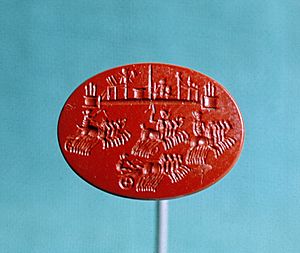
Sun and Moon gods were likely honored at the Circus from its earliest days. Their importance grew with the introduction of the Roman cult to Apollo. It also grew with the development of Stoic and solar monism as a religious idea for the Roman Imperial cult. In the Imperial era, the Sun-god was the divine protector of the Circus and its games. His sacred obelisk stood tall over the arena. It was in the central barrier, near his temple and the finish line. The Sun-god was seen as the ultimate, victorious charioteer. He drove his quadriga (four-horse chariot) through the sky from sunrise to sunset. His partner Luna (the Moon) drove her biga (two-horse chariot). Together, they represented the orderly movement of the universe and the cycle of time. This was mirrored in the Circus track. Luna's temple, likely built before Apollo's, burned down in the Great Fire of 64 AD. It was probably not replaced. Her worship was closely linked to Diana and Sol Indiges, usually identified as her brother. After her temple was lost, her worship might have moved to Sol's temple on the dividing barrier or one nearby.
Temples to several gods overlooked the Circus; most are now gone. Temples to Ceres and Flora stood close together on the Aventine. They were roughly opposite the Circus's starting gate, which was protected by Hercules. Further southeast on the Aventine was a temple to Luna, the moon goddess. Aventine temples to Venus Obsequens, Mercury, and Dis (or perhaps Summanus) stood on the slopes above the southeast turn. On the Palatine hill, opposite Ceres's temple, was the temple to Magna Mater. And roughly opposite Luna's temple, there was one for the sun-god Apollo.
Several festivals were held at the Circus. The Consualia, with its story of Romulus, and the Cerealia, a major festival for Ceres, were probably older than the first "Roman Games" (Ludi Romani). These were held at the Circus in honor of Jupiter in 366 BC. In the early Imperial era, Ovid described the start of Cerealia (mid to late April). It began with a horse race at the Circus. Then, at night, foxes with lit torches on their tails were released into the stadium. There was likely an early connection between Ceres, the goddess of grain, and Consus, the god of grain storage and protector of the Circus.
The Circus Maximus Today: A Modern Park
After the 6th century, the Circus was no longer used and began to decay. The lower parts, which often flooded, were slowly buried under wet soil and debris. The original track is now six meters (about 20 feet) below the modern ground. In the 11th century, the Circus area was used for homes. In the 12th century, a water channel was dug to drain the soil. By the 16th century, the area became a market garden. During the Renaissance, the site was used as a quarry for building stone.
Many of the Circus's standing structures survived these changes. In 1587, two obelisks were moved from the central barrier by Pope Sixtus V. One of these was placed in the Piazza del Popolo. In 1852, a gas works was built on the site. It stayed there until 1910 when it moved to the edge of Rome. In the mid-19th century, excavations at the Circus site uncovered parts of a seating tier and outer portico. Since then, more excavations have revealed other sections of the seating, curved turn, and central barrier. However, further exploration is difficult due to the site's size, depth, and waterlogging.
Today, the Circus Maximus site is a large park. It is open to the public and often used for concerts, meetings, and celebrations.
Images for kids
-
Italian World Cup 2006 victory celebration at the site of the Circus
See also
 In Spanish: Circo Máximo para niños
In Spanish: Circo Máximo para niños
- Circus of Maxentius
- Amphitheatre
- Forma Urbis Romae
- List of closed stadia by capacity
- Hippodrome of Constantinople


